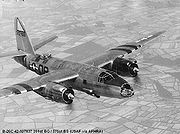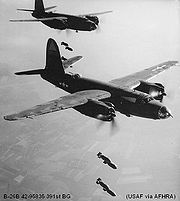
RAF Matching
Encyclopedia


Essex
Essex is a ceremonial and non-metropolitan county in the East region of England, and one of the home counties. It is located to the northeast of Greater London. It borders with Cambridgeshire and Suffolk to the north, Hertfordshire to the west, Kent to the South and London to the south west...
, England. The airfield is located approximately 5 miles (8 km) east of Harlow
Harlow
Harlow is a new town and local government district in Essex, England. It is located in the west of the county and on the border with Hertfordshire, on the Stort Valley, The town is near the M11 motorway and forms part of the London commuter belt.The district has a current population of 78,889...
; about 22 miles (35.4 km) northeast of London
Opened in 1944, it was used by both the Royal Air Force
Royal Air Force
The Royal Air Force is the aerial warfare service branch of the British Armed Forces. Formed on 1 April 1918, it is the oldest independent air force in the world...
and United States Army Air Force. During the war it was used primarily as a bomber airfield. After the war it was closed in 1946.
Today the remains of the airfield are located on private property being used as agricultural fields.
Overview
Matching airfield was constructed during 1943 by the 834th and 840th Engineer Battalions (Aviation) of the United States Army. It was originally allocated to the USAAF by the Air Ministry in August 1942, and it was planned to be ready for use in the following spring. Due to various construction delays, it was not suitable for occupation until December 1943.The airfield was designed to be built to the Class A airfield
Class A airfield
Class A airfields were military installations originally built for the Royal Air Force in the Second World War. Several were transferred to the U.S...
specification for bomber use, the main feature of which was a set of three converging runways each containing a concrete runway for takeoffs and landings, optimally placed at 60 degree angles to each other in a triangular pattern. The airfield consisted of three runways of 6,000 ft (03/21), 4,200 ft (19/27), and 4,000 ft (14/32). 50 "Loop" hardstands were constructed connecting to an enclosing perimeter track, of a standard width of 50 feet.
The ground support station was constructed largely of Nissen hut
Nissen hut
A Nissen hut is a prefabricated steel structure made from a half-cylindrical skin of corrugated steel, a variant of which was used extensively during World War II.-Description:...
s of various sizes located on the southeast side of the airfield. The support station was where the group and ground station commanders and squadron headquarters and orderly rooms were located. Also on the ground station were where the mess facilities; chapel; hospital; mission briefing and debriefing; armory and bombsite storage; life support; parachute rigging; supply warehouses; station and airfield security; motor pool and the other ground support functions necessary to support the air operations of the group. These facilities were all connected by a network of single path support roads.
The technical site, connected to the ground station and airfield consisted of at least two T-2 type hangars and various organizational, component and field maintenance shops along with the crew chiefs and other personnel necessary to keep the aircraft airworthy and to quickly repair light and moderate battle damage. Aircraft severely damaged in combat were sent to repair depots for major structural repair. The Ammunition dump was located on the south side of the airfield, outside of the perimeter track surrounded by large dirt mounds and concrete storage pens for storing the aerial bombs and the other munitions required by the combat aircraft.
Various domestic accommodation sites were constructed dispersed away from the airfield to the east, but within a mile or so of the technical support site, also using clusters of Maycrete or Nissen huts. The Huts were either connected, set up end-to-end or built singly and made of prefabricated corrugated iron with a door and two small windows at the front and back. They provided accommodation for 2,282 personnel, including communal and a sick quarters.
In late 1944, the airfield was considered for enlargement with extended runways to accommodate Boeing B-29 Superfortresses for Very Heavy bomber use against Nazi Germany, but this plan was discarded with the end of the European war in May 1945.
USAAF use
Matching was known as USAAF Station AAF-166 for security reasons by the USAAF during the war, and by which it was referred to instead of location. It's USAAF Station Code was "MT".391st Bombardment Group
The first combat organisation, the 391st Bombardment Group391st Bombardment Group
The 391st Bombardment Group is an inactive United States Army Air Force unit. Its last assignment was with the Army Service Forces stationed at Camp Shanks, New York...
, arrived at Matching on 26 January 1944 from Goodman AAF
Fort Knox
Fort Knox is a United States Army post in Kentucky south of Louisville and north of Elizabethtown. The base covers parts of Bullitt, Hardin, and Meade counties. It currently holds the Army Human Resources Center of Excellence to include the Army Human Resources Command, United States Army Cadet...
, Kentucky
Kentucky
The Commonwealth of Kentucky is a state located in the East Central United States of America. As classified by the United States Census Bureau, Kentucky is a Southern state, more specifically in the East South Central region. Kentucky is one of four U.S. states constituted as a commonwealth...
flying Martin B-26 Marauder
B-26 Marauder
The Martin B-26 Marauder was a World War II twin-engine medium bomber built by the Glenn L. Martin Company. First used in the Pacific Theater in early 1942, it was also used in the Mediterranean Theater and in Western Europe....
s. Operational squadrons of the group were:
- 572d Bombardment Squadron572d Bombardment SquadronThe 572d Bombardment Squadron is an inactive United States Air Force unit. Its last was assigned to the 391st Bombardment Group, stationed at Camp Patrick Henry, Virginia. It was inactivated on 29 October 1945.-History:...
(P2) - 573d Bombardment Squadron573d Bombardment SquadronThe 573d Bombardment Squadron is an inactive United States Air Force unit. Its last was assigned to the 391st Bombardment Group, stationed at Camp Myles Standish, Massachusetts. It was inactivated on 13 October 1945.-History:...
(T6) - 574th Bombardment Squadron574th Bombardment SquadronThe 574th Bombardment Squadron is an inactive United States Air Force unit. Its last was assigned to the 391st Bombardment Group, stationed at Camp Shanks, New York. It was inactivated on 15 October 1945.-History:...
(4L) - 575th Bombardment Squadron575th Bombardment SquadronThe 575th Bombardment Squadron is an inactive United States Air Force unit. Its last was assigned to the 391st Bombardment Group, stationed at Camp Patrick Henry, Virginia. It was inactivated on 29 October 1945.-History:...
(O8)
The group marking was a yellow triangle painted on the tail fin of their B-26s.
The first mission was flown on 15 February and 150 more were completed before the group moved into France in late September 1944. During the ensuing weeks the 391st bombed targets such as airfields, marshalling yards, bridges, and V-weapon sites in France and the Low Countries
Low Countries
The Low Countries are the historical lands around the low-lying delta of the Rhine, Scheldt, and Meuse rivers, including the modern countries of Belgium, the Netherlands, Luxembourg and parts of northern France and western Germany....
to help prepare for the invasion of Normandy
D-Day
D-Day is a term often used in military parlance to denote the day on which a combat attack or operation is to be initiated. "D-Day" often represents a variable, designating the day upon which some significant event will occur or has occurred; see Military designation of days and hours for similar...
. The group attacked enemy defenses along the invasion beaches on 6 and 7 June 1944
D-Day
D-Day is a term often used in military parlance to denote the day on which a combat attack or operation is to be initiated. "D-Day" often represents a variable, designating the day upon which some significant event will occur or has occurred; see Military designation of days and hours for similar...
. From June through September, the group continued cross-Channel operations, which included attacks on fuel dumps and troop concentrations in support of Allied forces during the breakthrough at Saint-Lô
Saint-Lô
Saint-Lô is a commune in north-western France, the capital of the Manche department in Normandy.-History:Originally called Briovère , the town is built on and around ramparts. Originally it was a Gaul fortified settlement...
in July 1944, and strikes on transportation and communications to block the enemy's retreat to the east.
A total of 20 B-26s were missing in action during the 391st's operations from Matching before the group moved onto the continent, transferring to Roye/Amy, France (ALG A-73) on 19 September 1944. The group then switched to Douglas A-26 Invaders and flew its last mission on 3 May 1945 from Asche, Belgium (ALG Y-29).
The 391st Bomb Group returned to the United States in October and was inactivated at Camp Shanks, New York
New York
New York is a state in the Northeastern region of the United States. It is the nation's third most populous state. New York is bordered by New Jersey and Pennsylvania to the south, and by Connecticut, Massachusetts and Vermont to the east...
on 25 October 1945.
With the move of the 391st to France, this was the end of Matching airfield's association with the Ninth Air Force as a combat airfield.
RAF use
Douglas C-47 Skytrains of IX Troop Carrier Command were detached to Matching later in 1944 for exercises with British paratroops. The next occupants were the Short StirlingShort Stirling
The Short Stirling was the first four-engined British heavy bomber of the Second World War. The Stirling was designed and built by Short Brothers to an Air Ministry specification from 1936, and entered service in 1941...
s of the training unit for the airborne force's squadrons which remained until 1946. Late in the war, the airfield was used by the following RAF units: No 3 Group Bomber Command No 38 Group.
In 1946 the airfield was closed and sold to private owners.
Civil use
With the facility released from military control, it was rapidly returned to agricultural use and the concrete was soon removed for road hardcore but the hangar on the technical site survived for farm use. However, in the late 1980s the T-2 Hanagar was dismantled and re-erected at North Weald for Aces High where it was used for TV productions, including 'The Crystal Maze' set.The control tower still stands a half century after it was built and for some years has been used for radar experiments by Cossor Electronics. Many remaining Nissen Huts and corregated roof buildings in the former technical site are now used for small industrial units, farming and storage along with the water tower.
Part of the main runway (03/21) that remains is now used as a public road and another surviving portion was used for heavy goods vehicle instruction. Many single-width sections of the perimeter track are used for agricultural vehicles. However very little of the runways, perimeter track or dispersal hardstands of the former airfield survive. Even in aerial photography, there is very little evidence of the airfield's existence.
A memorial plaque to the men of the 391st Bomb Group is housed in Matching Church.

